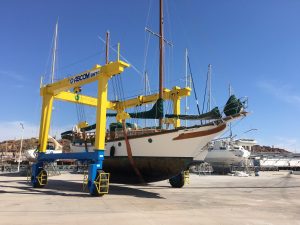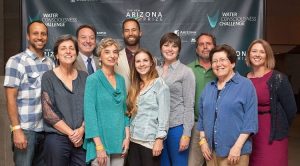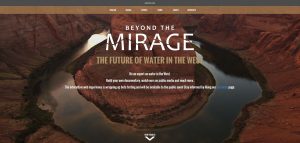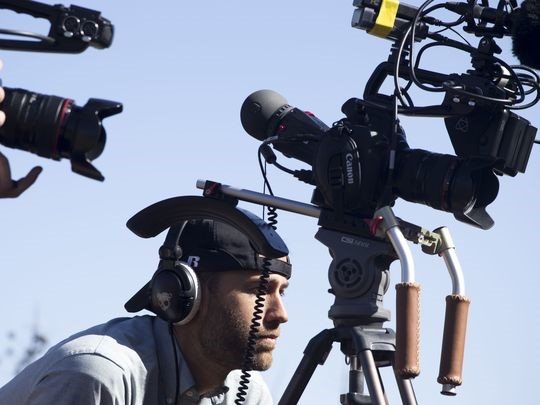Water Mirage Found in Desert Cities
A boat yard, crammed full with more than a hundred powerboats, sailboats and pontoon boats, bakes in the white washed light of a hot Mexican sun. Standing within the maze of bleached white hulls laid crisscross within the yard, Cody Sheehy, the captain of the 47-foot sailboat Endymion, is striking deals with the locals. His sailboat needs a new rudder.
In the past, he’s relied on his own hands to fix his boat. He’s replaced the engine, resurfaced the deck and rewired the entire boat among countless projects. There’s always something to do. “I know this boat better than my own house,” Sheehy says.
But this time Sheehy has neither the time nor the resources to complete this task on his own. He’s looking for a team of professionals. One that he can trust and that can help him put the Endymion back in the water.

Beyond the Mirage
After living on his sailboat for more than five years, Sheehy recently traded his flip-flops for dress shoes and his wooden steering wheel for a laptop. Although he’s regained his land legs, Sheehy applies the same strategy of dedication and hard work that he uses on the Endymion to push his latest project “Beyond the Mirage”.
Beyond the Mirage is a multi-platform communication project that aims to change the way people think about water in the Southwestern United States. The West has a consistent history of growth and accomplishment, but the water delivery system upon which it was built, is challenged by projections of future demand. The pairing of over pumping groundwater and over allocating river supplies has put the Southwest between the jaws of a water vice. Simply put, the supply and demand scales are unbalanced. As we look into the future, there just isn’t enough water to go around.
On the one hand, the Southwest’s supply of water is dwindling, and on the other, the states must continue to provide water for a growing population, agriculture and industry. “The projections are, in Arizona that within the next 25 to 30 years there’ll be about a 1.2 million acre feet gap in water supply,” the Arizona State Director of the Nature Conservancy Patrick Graham said.
Endymion is one of the bigger sailboats in the marina, it weights close to 40,000 lbs. and its mast stands nearly 60 feet above the water. A lot of sailing knowledge and good ol’ fashioned elbow grease goes into navigating a boat this size. By comparison, Beyond the Mirage is more like a 16th century 500-ton Spanish galleon. There’s no way that Sheehy could handle Beyond the Mirage by himself. The project, which includes a full length PBS documentary, a unique interactive web application and a national educational component, took 18 months of hard work by a team of more than a dozen professionals to complete.
But the beginning of the story began three years ago, in South America. At the time Sheehy, his wife Jatta and their two dogs were living on the Endymion and were in the middle of a nine-month sailing adventure that would take them up and down the Pacific Coast. The ping of an email changed the course of Sheehy’s sailing adventure and his life.
The change presented itself in the form of a job. The University of Arizona’s College of Agriculture and Life Sciences was looking for a video storyteller and Sheehy was on the short list of desired applicants. The idea of leaving the freedom of the sea for a shot at a potential job wasn’t enough, though. Sheehy needed a purpose to leave.
Not quite knowing what to do, Sheehy turned to his mentor Craig Miller, the current science editor for KQED (San Francisco’s local PBS affiliate), for advice. Miller said to Sheehy, “If you’re going to be moving to the Southwest, there is one story that you have to tell, and that story is water.”
With aspirations of telling such a monumental story, Sheehy would point the Endymion towards his future home of Tucson, Arizona. It would be at the University of Arizona where Sheehy would assemble his team and where the Beyond the Mirage project would evolve from an idea into the movement that it is today.
Building the Team

With the help of his supervisor Dave Bogner, Sheehy would lay the groundwork for Beyond the Mirage over the course of the next year.
John Booth, the executive producer at Arizona Public Media (the Tucson PBS affiliate) also signed on to Beyond the Mirage in the project’s early stages. He is the executive producer on Beyond the Mirage and is also essential to the film’s future television presence. According to Booth,“The combination of Cody’s story telling skills and his respect for science is what attracted me to the project. As a native Arizonan and long time filmmaker myself I was thrilled to be given the opportunity to help raise the public’s consciousness of the past, present, and future of water in the west.” The 90-minute version of Beyond the Mirage is set to air on PBS in Tucson on April 15 and on PBS in Phoenix on May 16.
Other team members J.D. Gibbs, Craig Boesewetter, Kim Daly and Matt Rahr were fundamental to building the Beyond the Mirage interactive web experience. “The big thing for me was the topic of water,” Gibbs said, “to help push the awareness of that project. And also taking documentary like content and making it into something that our younger audience would enjoy was a big thing for me.”
Sheehy, having a background in the sciences, understood how important it would be to partner real experts, like Sharon Megdal, the director of Arizona’s Water Resources Research Center (WRRC). The WRRC has been described as boots on the ground in the frontlines of understanding and solving the West’s water situation. The WRRC kick started the Beyond the Mirage project with an initial investment in the concept and provided additional support as it matured.
Megdal and her staff Susanna Eden, Kerry Schwartz and Ashley Hullinger would provide Sheehy with massive amounts of information and a list of over 60 water experts to interview. The team has also fact checked all of Sheehy’s content to make sure that it was current and scientifically accurate. “We made an effort to be as rigorous with the facts” Eden said, “it was a challenge to balance that and to never lose site of the fact that Beyond the Mirage had to be interesting and engaging.”
However, one of the WRRC’s biggest contributions to the Beyond the Mirage campaign was to join Sheehy’s team and help lead the effort to apply for the $100,000 New Arizona Prize, Water Consciousness Challenge. Sponsored by the Arizona Community Foundation, the prize is aimed at raising water awareness in Arizona but with a twist. For decades, water professionals have been stressing the importance to conservation and the public has listened. Gains in conservation have helped stave off shortage until now and increased conservation will be a big part of the solution in the future. The twist is that now we need to add a deeper understanding of the challenges and solutions. For our leaders to make these tough calls, they are going to need the support of an informed and aware public that leads to a fundamental change of the system.

The team believed that the Beyond the Mirage concept exactly captured the goals of the Water Consciousness Challenge. For months Sheehy and his team had worked days, nights and weekends to develop the Beyond the Mirage web experience, which now serves as the backbone for the project.
The web experience is best explained by the project’s press release:
“Home to 250 video clips (ranging anywhere from ten seconds to two minutes), the Beyond the Mirage website provides for an interactive exploration of the complex problems and potential solutions inherent to the Southwest’s water supply. After one click, users start their travels through the constellation of clips available on the website. A smart algorithm presents users with an array of clip choices that reflect their interests. Users can then connect clips together to tell a water story. This interaction gives users a professional documentary-like experience and prompts active learning. User-created documentaries can be saved and their creators can share them through social media.”
With his team in place and the project well underway, the New Arizona Prize application was submitted and was judged to be among the top five. “Sheehy and Booth had to take the stage.” Sheehy explains, “We were expecting a grant application and an interview, but when we arrived in Phoenix it dawned on us that we were going to be competing against other teams with a live audience. There were bright lights and a countdown clock. It was intense.”
Despite the high stakes and pressure, Sheehy’s team would win the prize and gain important support for carrying out the Beyond the Mirage campaign. “I remember getting a call from the Dean (of the College of Agriculture and Life Sciences) at like eight o’clock, congratulating us” Department Director Matt Rahr said, he was so excited about our team winning the prize that he contacted us personally.”
With the $100,000 prize secured, Sheehy and his team would spend the next 10 months finishing the Beyond the Mirage project and securing additional resources in which the WRRC was again instrumental. Sheehy would travel all over the Southwestern United States talking to heavy hitters in the water game such as Arizona’s former senator Jon Kyl, Pat Mulroy the former water Tsar of Southern Nevada water and Lester Snow the former Secretary of Natural Resources in California. He would also travel abroad to China and more importantly to Israel to learn from the people who solved Israel’s 1970’s water shortage, which, though much smaller in scope was very similar to what the Southwest is seeing today. “My favorite place had to be filming in the Rockies, showing up at dusk to fly the drone over the mountains really felt like we were shooting an epic film,” Sheehy said.
Set to Sail
After years of work and preparation, the initial stage of Beyond the Mirage is approaching completion.
“Beyond the Mirage is way beyond what you would expect for the resources that were used to do it,” Sheehy’s supervisor Dave Bogner said, “You see something like this and normally you’d expect it to have a budget realistically more than ten times what this budget was.
On March 15th the web application will be made available to the public. The launch will be celebrated at parties in both Phoenix and Tucson. The team’s documentary is set to air on PBS in Tucson on April 15 and on PBS in Phoenix on May 16. However, the team is still hustling to the finish line. “It feels like finals week to me,” Sheehy said, “And we are cramming it all in and trying to be prepared as possible.”
The figurative champagne is being pulled out of the icebox and is ready to be smashed upon the hull of Beyond the Mirage but Sheehy said that the project is missing one essential piece. “We’ve built a great team of top scientists, award winning PBS filmmakers and we’ve got excellent distribution in place,” Sheehy said, “but there’s one piece missing, and that piece is the public. We need to hear their opinions and we want them to be part of the conversation on Facebook and Twitter. We all have a stake in this and we need to be informed on what the choices are going to be.”
To see what’s possible, check out the team’s splash page: http://beyondthemirage.org/
From time to time, Water – Use it Wisely features guest bloggers who write about topics related to water and water conservation. The author of this blog post, Alan Davis, is an associate producer of the Beyond the Mirage documentary.


